A manual transfer case is a crucial component in four-wheel-drive vehicles, enabling the distribution of power between front and rear axles. Known for mechanical simplicity and durability, it provides drivers with direct control over the drivetrain, enhancing off-road capability and traction. This system is preferred for its reliability and cost-effectiveness compared to automatic alternatives, making it a popular choice for off-road enthusiasts and heavy-duty applications.
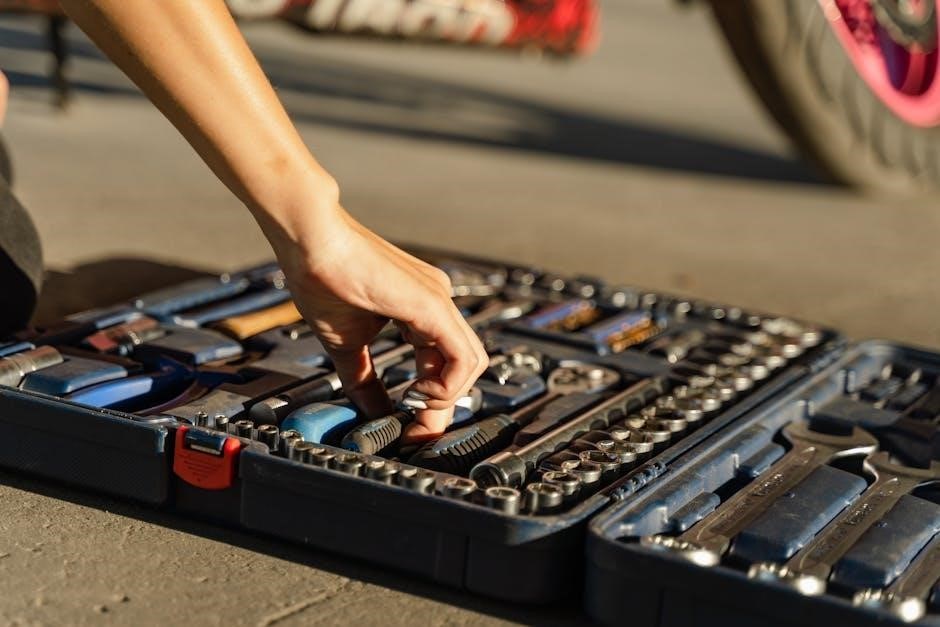
Components of a Manual Transfer Case
A manual transfer case consists of essential parts, including gearsets, bearings, a control lever, mode selector, and housing; These components work together to ensure smooth power distribution and drivetrain control.
2.1 Gearsets
Gearsets are a fundamental component of a manual transfer case, responsible for transmitting power between the front and rear axles. They consist of interlocking gears that engage or disengage to allocate torque. Spur gears, helical gears, and planetary gear systems are commonly used, each offering distinct advantages in noise reduction, strength, and compactness. The gear ratio determines the speed and torque output, making them critical for both on-road and off-road performance. Proper lubrication and alignment are essential to ensure smooth operation and prevent wear. Gearsets are designed to handle varying loads, providing durability and reliability in demanding conditions. Regular maintenance, such as fluid checks, helps extend their lifespan and maintain optimal functionality.
2.2 Bearings
Bearings are essential components in a manual transfer case, enabling smooth operation of moving parts by reducing friction. They support gears, shafts, and other rotating elements, preventing wear and tear. Common types include ball bearings and roller bearings, each designed for specific load types: ball bearings excel at handling thrust loads, while roller bearings manage radial loads effectively. Proper lubrication is critical to prevent overheating and ensure longevity. Typically made from high-carbon steel, bearings provide durability under stress. Their role in maintaining smooth power transmission and overall system reliability, especially in demanding off-road conditions, is vital. Bearings are fundamental to the transfer case’s efficiency and longevity, ensuring optimal performance across various driving scenarios.
2.3 Control Lever
The control lever in a manual transfer case is a critical component that allows the driver to manually engage or disengage four-wheel drive. Typically located on the floor or steering column, it provides a direct mechanical connection to the transfer case. By moving the lever, the driver actuates the mode selector, enabling the transfer of power between the front and rear axles. The lever’s design ensures precise control, with a robust construction to withstand rough handling. Its simplicity and durability make it a reliable feature for off-road enthusiasts, offering immediate response and minimal effort required for operation. The control lever is essential for seamlessly switching between two-wheel and four-wheel drive modes, enhancing traction and stability in varying terrain conditions while maintaining driver control.
2.4 Mode Selector
The mode selector in a manual transfer case is a mechanism that allows the driver to choose between different operating modes, such as two-wheel drive (2WD) and four-wheel drive (4WD). This component is integral to the transfer case, ensuring smooth transitions between modes by engaging or disengaging the front and rear axles. The mode selector operates in conjunction with the control lever, offering drivers the flexibility to adapt to various driving conditions. Its design emphasizes durability and precision, minimizing wear and tear while providing consistent performance. By enabling the driver to switch modes manually, the mode selector enhances vehicle adaptability, improving traction and control on diverse terrains without the need for automatic systems, thus maintaining mechanical simplicity and reliability.
2.5 Housing
The housing of a manual transfer case is the outer casing that encloses and protects the internal components, such as gearsets, bearings, and shafts. Typically constructed from durable materials like aluminum or steel, the housing is designed to withstand the stresses of off-road environments and heavy-duty use. It provides a rigid structure that maintains the alignment of internal parts, ensuring proper gear engagement and smooth operation. The housing also serves as a mounting point for the transfer case, securing it to the vehicle’s chassis. Its design often includes features like sealing systems to prevent contamination and maintain lubrication. The housing’s durability and structural integrity are critical to the overall reliability and performance of the manual transfer case.
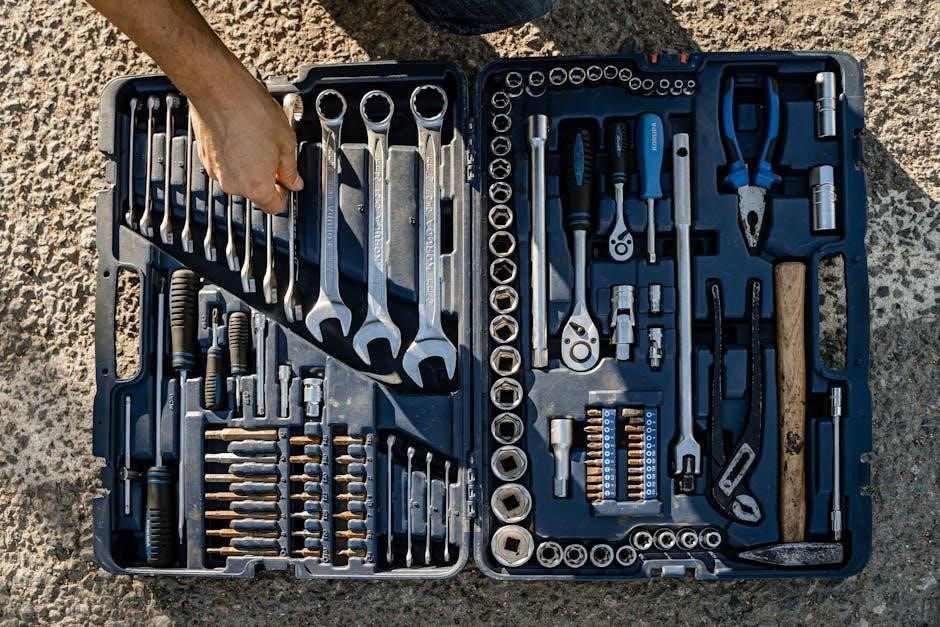
How It Works
A manual transfer case operates by allowing the driver to control the distribution of power between the front and rear axles via a mechanical system. The driver engages or disengages four-wheel drive using the control lever, which activates gears and bearings to send power to the selected axles. This system provides direct control over the drivetrain, enhancing traction and off-road capability through a simple and reliable mechanical process.
3.1 Basic Operation
The basic operation of a manual transfer case involves the driver manually switching between two-wheel drive (2WD) and four-wheel drive (4WD) modes. This is achieved through a control lever connected to the transfer case, which engages or disengages the front and rear axles. When the driver moves the lever, it activates internal gears and bearings to distribute power to the selected axles. In 2WD mode, power is sent only to the rear wheels, while in 4WD mode, power is split between both axles for improved traction. The process is mechanically straightforward, requiring the driver to stop or slow down before switching modes to prevent damage to the drivetrain. This simplicity ensures reliable performance in various driving conditions, particularly off-road or in low-traction situations.
3.2 Role of the Control Lever
The control lever in a manual transfer case is a driver-operated mechanism that enables the selection of different drivetrain modes. Located on the floor or dashboard, it allows the driver to manually engage or disengage four-wheel drive. The lever connects to the transfer case via a mechanical linkage, activating internal components to distribute power to the front and rear axles. Its primary function is to provide a straightforward way to switch between two-wheel drive (2WD) and four-wheel drive (4WD) modes, ensuring optimal traction and control in various driving conditions. Proper use of the control lever requires the driver to stop or slow down to avoid damaging the drivetrain during mode transitions, making it a critical component for safe and effective operation.
3.3 Engaging and Disengaging 4WD
Engaging and disengaging four-wheel drive (4WD) in a manual transfer case involves a straightforward process. To activate 4WD, the driver must stop the vehicle, ensure the transmission is in neutral, and use the control lever to select the desired mode, such as high-range 4WD (4H) or low-range 4WD (4L). The transfer case then mechanically locks the front and rear axles together, distributing power evenly. Disengaging 4WD involves reversing the process, typically returning to two-wheel drive (2H) mode. Proper technique is essential to avoid damage to the drivetrain. Always follow manufacturer guidelines and ensure the vehicle is stationary or moving at a very slow speed during mode transitions to maintain system integrity and functionality.
3.4 Manual vs. Automatic Transfer Cases

Manual and automatic transfer cases differ significantly in design and functionality. Manual transfer cases rely on driver input through a control lever, offering direct control over mode selection. They are mechanically simpler, more durable, and cost-effective, making them ideal for off-road use. Automatic transfer cases, in contrast, use electronic sensors and actuators to engage 4WD automatically when traction loss is detected. While automatic systems provide convenience and seamless operation, they are generally more complex and expensive to maintain. Manual systems, however, require driver awareness and intervention, offering a more hands-on experience. Each type caters to different driving needs, with manual systems favored for rugged conditions and automatic systems preferred for everyday convenience and ease of use.

Types of Manual Transfer Cases
Manual transfer cases come in two-speed and four-speed variants, offering low and high range options for varying terrain. They also feature part-time or full-time 4WD capabilities, enhancing versatility and traction control.
4.1 Two-Speed Transfer Cases
A two-speed transfer case is designed to provide two gear ratios, typically a low range and a high range. This allows drivers to switch between normal driving conditions and challenging off-road scenarios. The low range offers increased torque for better traction in difficult terrains, such as steep inclines or muddy surfaces, while the high range is suitable for standard driving on paved roads. These transfer cases are known for their mechanical simplicity, durability, and cost-effectiveness, making them a popular choice for off-road enthusiasts. They are often paired with manual controls, enabling precise driver input and enhancing overall vehicle performance in varied driving conditions.
4.2 Four-Speed Transfer Cases
A four-speed transfer case offers enhanced flexibility with multiple gear ratios, providing drivers with more control over torque and speed. Unlike two-speed models, these units include additional intermediate gears, allowing for smoother transitions between driving conditions. They are ideal for vehicles that require precise power delivery in diverse terrains, such as heavy-duty trucks or specialized off-road vehicles. The added complexity of four-speed systems often results in increased weight and cost compared to two-speed transfer cases. However, the improved adaptability makes them a preferred choice for applications where varying torque demands are critical. This design ensures optimal performance in both low-range and high-range scenarios, catering to advanced off-road enthusiasts and professional users seeking superior control and versatility.
4.3 Part-Time vs. Full-Time 4WD
Part-time 4WD systems are designed for specific off-road conditions, requiring manual activation through the transfer case. They are ideal for scenarios like snow, mud, or sand, where maximum traction is needed. Full-time 4WD, in contrast, continuously sends power to all wheels, automatically adapting to varying road conditions without driver input. While part-time systems offer better fuel efficiency and reduced wear on drivetrain components, full-time systems provide superior stability and control on mixed surfaces. Manual transfer cases are typically paired with part-time systems, allowing drivers to switch between two-wheel and four-wheel drive modes. Full-time systems are more common in modern vehicles, often integrated with advanced electronics for seamless operation. Understanding these differences helps drivers choose the right setup for their needs.
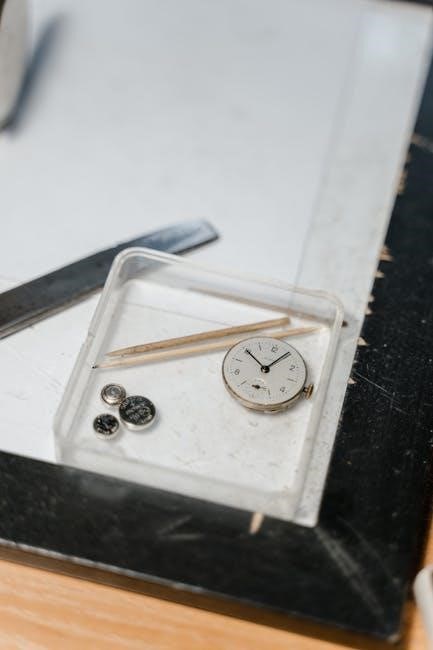
Advantages of Manual Transfer Cases
Manual transfer cases offer improved fuel efficiency, reduced drivetrain wear, and enhanced reliability. Their simplicity minimizes mechanical failures, making them ideal for rugged and off-road driving conditions.
5.1 Mechanical Simplicity
Manual transfer cases are renowned for their mechanical simplicity, which enhances reliability and reduces the risk of mechanical failures; With fewer components compared to automatic systems, they operate with a straightforward gearset and lever mechanism, eliminating complex electronics. This simplicity makes them highly durable and easier to maintain, as there are fewer parts prone to wear and tear. The lack of advanced sensors and actuators reduces the likelihood of malfunctions, especially in harsh off-road conditions. Additionally, the direct control provided by the manual lever ensures consistent performance, making it a preferred choice for drivers seeking a dependable and robust drivetrain solution. This simplicity also translates to easier diagnostics and repairs, further enhancing its practicality.
5.2 Cost-Effectiveness
Manual transfer cases are highly cost-effective, offering significant savings for vehicle owners. Their straightforward design, with fewer components compared to automatic systems, reduces production costs and lowers the overall price. Maintenance expenses are also minimized due to the simplicity of the mechanism, requiring less frequent servicing. Additionally, the durability of manual systems means fewer repairs and replacements over time. This makes them a budget-friendly option for drivers seeking dependable performance without the high costs associated with advanced technologies. Their reliability further enhances cost-effectiveness, as they require less frequent interventions, ensuring long-term savings for users.
5.3 Enhanced Durability
Manual transfer cases are renowned for their enhanced durability, making them a preferred choice for harsh driving conditions. Their robust construction and fewer moving parts result in less wear and tear compared to automatic systems. The absence of complex electronic components reduces the risk of mechanical failure, ensuring long-term reliability. This simplicity also minimizes the need for frequent repairs, further extending the lifespan of the transfer case. Additionally, manual systems are often built with heavy-duty materials, making them more resistant to stress and damage from off-road adventures or heavy-duty applications. Their durability ensures consistent performance and reduces maintenance needs, providing drivers with peace of mind and lower long-term ownership costs.

Installation of a Manual Transfer Case
Installing a manual transfer case requires careful preparation, proper tools, and mechanical expertise. It involves aligning the case with the vehicle’s drivetrain and ensuring secure mounting for optimal performance and durability.
6.1 Choosing the Right Transfer Case
Selecting the appropriate manual transfer case is essential for ensuring compatibility with your vehicle and meeting specific performance needs. Consider factors such as the vehicle’s make, model, and year, as well as its intended use, whether for daily driving or off-road adventures. The transfer case must align with the drivetrain’s specifications, including torque capacity and gear ratios. Additionally, decide between part-time or full-time 4WD systems based on your driving habits. Measure the space available for installation to avoid fitment issues. Research options like two-speed or four-speed cases for added versatility. Finally, consult manufacturer guidelines or seek professional advice to ensure the chosen transfer case optimizes your vehicle’s capabilities and enhances reliability.
6.2 Step-by-Step Installation Guide
Installing a manual transfer case requires careful preparation and mechanical expertise. Begin by raising the vehicle using a jack and securing it with jack stands for safety. Disconnect the battery to prevent accidental start-ups. Remove the driveshafts and old transfer case, taking note of the mounting points and connections. Inspect and clean the area to ensure a smooth installation. Align the new transfer case with the transmission and axles, ensuring proper fitment and alignment. Secure it using the original or new mounting hardware, tightening bolts to the manufacturer’s torque specifications. Reconnect the driveshafts, shift linkages, and electrical connectors. Finally, refill the transfer case with the recommended lubricant and test the system to ensure proper function.
6.3 Post-Installation Checks
After installing a manual transfer case, conduct a comprehensive post-installation inspection. Check all bolts and connections for tightness and ensure they are properly aligned. Inspect the housing and seals for any signs of fluid leaks. Test the control lever’s operation, ensuring smooth engagement and disengagement of four-wheel drive. Take the vehicle for a test drive on both paved roads and off-road terrains to evaluate performance and identify any unusual noises or vibrations. Verify that all electrical connections are secure and functioning correctly. Check the lubricant level and top it off if necessary, using the type recommended by the manufacturer. Finally, review the owner’s manual for any specific post-installation checks or recommendations. If any issues arise, consider consulting a professional mechanic to address them promptly. These checks ensure the transfer case operates efficiently and enhances your vehicle’s overall capability.
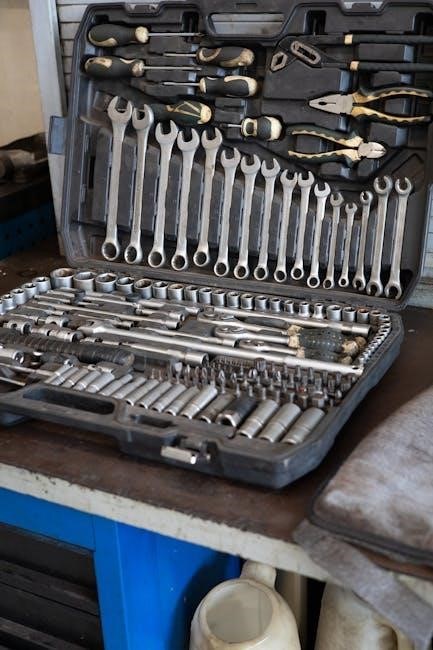
Maintenance and Care
Regular maintenance is essential for optimal performance. Check for wear, clean components, and ensure proper lubrication. Refer to the owner’s manual for specific care instructions.
7.1 Lubrication Requirements
Proper lubrication is essential for the smooth operation of a manual transfer case. Use the correct type and amount of gear oil or fluid specified in the owner’s manual. Regularly inspect the fluid level and condition, ensuring it’s clean and free from contaminants. Old or degraded lubricant can lead to excessive wear and premature failure. Replace the oil every 30,000 to 60,000 miles, depending on usage and manufacturer recommendations. After off-road use or in harsh conditions, check for leaks and top up as needed. Always use a torque wrench when refilling to avoid over-tightening, which can damage seals. Proper lubrication ensures optimal performance and extends the lifespan of the transfer case.
7.2 Sealing and Gasket Maintenance
Proper sealing and gasket maintenance are critical to prevent leaks and ensure the longevity of a manual transfer case. Inspect the seals and gaskets regularly for signs of wear, cracks, or degradation. Replace any damaged components immediately to avoid fluid leaks and contamination. Use only OEM-recommended seals and gaskets to guarantee compatibility and performance. When replacing, ensure all surfaces are clean and free from old adhesive or debris. Apply a thin layer of silicone-based sealant if specified by the manufacturer; After installation, check for leaks by inspecting the area around the gaskets. Regular maintenance helps maintain the integrity of the transfer case and prevents costly repairs down the line.
7.3 Regular Inspection
Regular inspection of a manual transfer case is essential to ensure optimal performance and prevent potential issues. Start by visually examining the housing for any signs of damage, dents, or rust. Check the control lever for smooth operation and ensure it engages and disengages properly. Inspect the mode selector for any wear or looseness, as this can affect the transfer case’s ability to switch between driving modes. Additionally, verify that all mounting points and bolts are secure to prevent vibration-induced damage. Monitor the lubrication level and condition, topping it off if necessary. Finally, look for any signs of leaks around the seals and gaskets. Regular inspections help identify and address problems early, ensuring the transfer case operates efficiently and reliably over time.
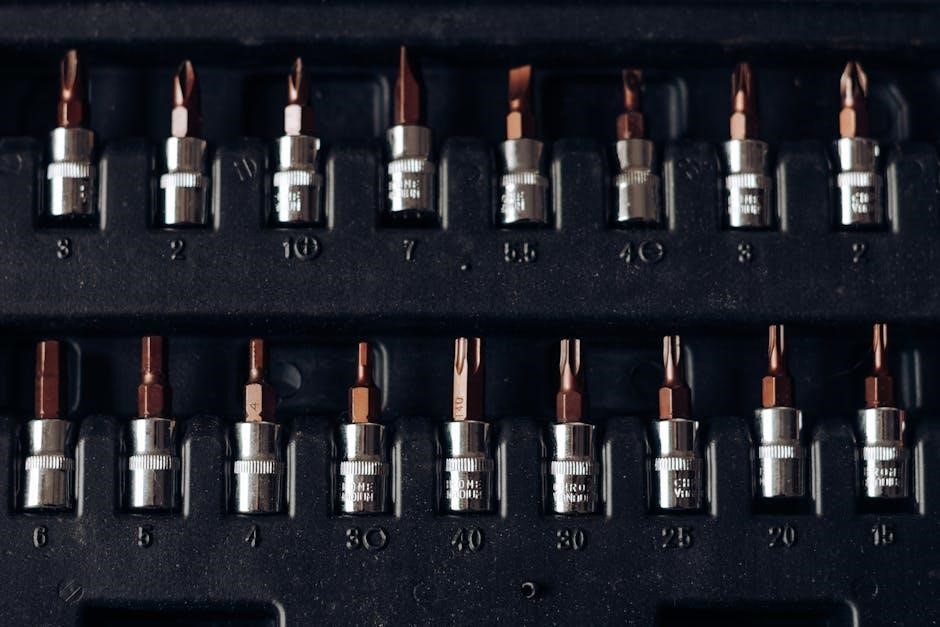
Troubleshooting Common Issues
Common issues with manual transfer cases include noise, vibration, or failure to engage 4WD. These problems often stem from worn bearings, low fluid levels, or damaged gearsets. Regular inspection and lubrication can prevent many of these issues, ensuring smooth operation and reliability. Identifying and addressing these problems early helps maintain optimal performance and avoids costly repairs.
8.1 Common Problems
Manual transfer cases often face issues like gear grinding, difficulty shifting, or failure to engage four-wheel drive. These problems can arise from worn bearings, misaligned components, or insufficient lubrication. Leaks in the housing or faulty seals may lead to fluid loss, reducing performance. Additionally, excessive noise or vibration during operation can indicate internal damage, such as chipped gears or worn-out shafts. In some cases, the control lever might stick or become hard to move, complicating the switching process. Regular maintenance, such as checking fluid levels and inspecting for wear, can help prevent these issues. Addressing problems promptly ensures the longevity and reliability of the transfer case.
8.2 Diagnostic Techniques
Diagnosing issues in a manual transfer case involves a combination of visual inspection, performance testing, and mechanical analysis. Start with a visual check for signs of wear, damage, or fluid leaks around seals and joints. Listening for unusual noises during operation can help identify faulty bearings or misaligned gears. Testing the engagement of four-wheel drive and monitoring its performance under load can reveal issues like slipping or lack of traction. Inspecting the gear teeth for chips or excessive wear is also crucial. Additionally, checking the fluid level and condition can indicate contamination or insufficient lubrication. Using specialized tools, such as pressure gauges, can help measure internal pressure and detect leaks. If problems persist, disassembling the unit for a detailed internal inspection may be necessary to pinpoint the root cause.
8.3 Repair and Replacement
Repairing or replacing a manual transfer case can be a complex process, often requiring specialized tools and mechanical expertise. If internal components like gears or bearings are damaged, partial or complete disassembly may be necessary. Inspecting for wear or damage to gear teeth, shafts, and bearings is critical. Replacement of faulty parts with OEM or high-quality aftermarket components is essential for restoring functionality. Reassembling the unit must be done with precision, ensuring proper alignment and torque specifications. After reinstallation, it’s vital to check for leaks, test engagement of 4WD, and ensure smooth operation under various loads. If repairs are too extensive, replacing the entire transfer case with a rebuilt or new unit may be the most cost-effective solution.

Frequently Asked Questions
Common inquiries about manual transfer cases include understanding their operation, maintenance, and troubleshooting. Users often ask about optimal usage scenarios and differences from automatic systems.
9.1 When to Use a Manual Transfer Case
A manual transfer case is ideal for off-road enthusiasts and heavy-duty applications where driver control is essential. It’s best suited for scenarios requiring precise traction distribution, such as rock crawling or deep mud, where manual engagement ensures optimal performance. Additionally, vehicles frequently transitioning between on-road comfort and off-road capability benefit from its mechanical simplicity and reliability. Drivers preferring direct control over their drivetrain to enhance off-road capability and traction will find it advantageous. Its durability and cost-effectiveness make it a preferred choice for those prioritizing mechanical simplicity over automatic convenience.
9.2 Manual vs. Automatic Transfer Cases
Manual and automatic transfer cases differ significantly in operation and application. Manual transfer cases require driver intervention to engage or disengage four-wheel drive, offering precise control and mechanical simplicity. They are cost-effective, durable, and ideal for off-road enthusiasts who value direct command over their drivetrain. Automatic transfer cases, however, operate seamlessly without driver input, adapting to traction needs in real-time. They are better suited for daily driving and varying road conditions, providing convenience and ease of use. While manual systems excel in rugged environments, automatic systems are preferred for their versatility and hands-free functionality, making them a better choice for drivers prioritizing comfort and adaptability.
9.3 Can I Upgrade My Transfer Case?
Upgrading a manual transfer case is possible for enhanced performance or to adapt to different driving needs. Drivers can opt for heavier-duty models or switch to automatic systems for convenience. Assessing the vehicle’s requirements and budget is crucial before making a change. Choosing a compatible transfer case ensures proper integration with existing drivetrain components. Professional installation is recommended to avoid complications. Regular maintenance after the upgrade is essential to maintain optimal functionality. Upgrading can significantly improve a vehicle’s capabilities, offering better traction and control in various driving conditions. Always consult with experts to ensure the upgrade aligns with the vehicle’s specifications and intended use.